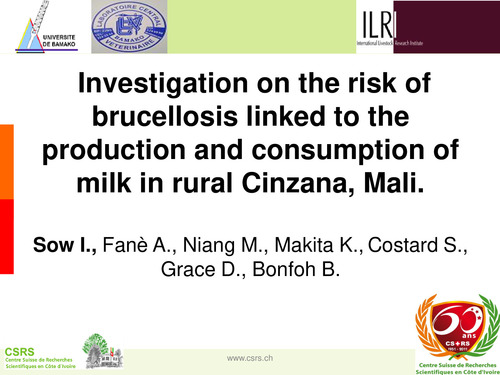Investigation on the risk of brucellosis linked to the production and consumption of milk in rural Cinzana, Mali
Abstract
Background: The objective of this study was to assess the risk of brucellosis associated with different hygiene practices in the informal dairy production sector in rural Mali and local milk consumption habits. Methods: A cross-sectional study was conducted in 12 villages in the rural commune of Cinzana in Mali, and consisted of two complementary surveys. The first used a participatory approach, based on focus group discussion coupled with open question interviews during general meetings in villages. Its objective was to describe attitudes and practices related to milk production and consumption. The second was a prevalence survey conducted in parallel on humans and dairy herds. In each selected household, serum was collected from people consuming
milk or in contact with livestock, after written consent was given. A questionnaire on livestock management practices and milk consumption habits was also administered to households included in the study. Two types of biological samples were collected from dairy cows and goat: raw milk and serum. Screening agglutination Ring test was carried out on milk samples. Rose Bengal test was performed on all human and animal sera. Positive Rose Bengal samples were tested by ELISA for confirmation. Human sera positive to ELISA were re-submitted to a Rose Bengal test by dilution.
This confirmatory test allows differentiating between actual infection and exposure to the pathogen. Results: Positive results to the ring test were obtained for 5.9% (2/34) of milk samples from cows and 1.3% (1/75) of milk samples from goat. Only 1.0% (2/204) of sera from cows and 0.7% (3/404) of sera from goat were positive to the Rose Bengal test. The same test gave positive results in 0.9% (2/213) of human sera. All animal positive with Rose Bengal yielded negative results with ELISA, while one serological human case was found. This case was recorded in the village where the 2 positive cow milk samples came from, and where cattle herds are managed individually rather than by the community. The results indicated that 100% and 98.1% of respondents consume
milk from cow or goat respectively without prior heating. Handling of abortion material was also common amongst respondents: 72.7% reported it with goats, 6.1% with cows and 11.3% with both species. Summary: This study confirms the presence of human and animal brucellosis in the rural area of Cinzana, Mali. The prevalence found in this study was very low despite widespread risky production and consumption practices. Further investigations on risk factors and preventive practices would be valuable.

